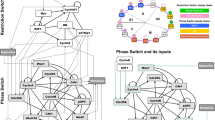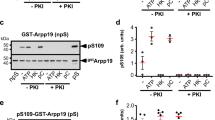Abstract
The maturation of Xenopus oocytes can be thought of as a process of cell fate induction, with the immature oocyte representing the default fate and the mature oocyte representing the induced fate1,2. Crucial mediators of Xenopus oocyte maturation, including the p42 mitogen-activated protein kinase (MAPK) and the cell-division cycle protein kinase Cdc2, are known to be organized into positive feedback loops3. In principle, such positive feedback loops could produce an actively maintained ‘memory’ of a transient inductive stimulus and could explain the irreversibility of maturation3,4,5,6. Here we show that the p42 MAPK and Cdc2 system normally generates an irreversible biochemical response from a transient stimulus, but the response becomes transient when positive feedback is blocked. Our results explain how a group of intrinsically reversible signal transducers can generate an irreversible response at a systems level, and show how a cell fate can be maintained by a self-sustaining pattern of protein kinase activation.
This is a preview of subscription content, access via your institution
Access options
Subscribe to this journal
Receive 51 print issues and online access
$199.00 per year
only $3.90 per issue
Buy this article
- Purchase on Springer Link
- Instant access to full article PDF
Prices may be subject to local taxes which are calculated during checkout




Similar content being viewed by others
References
Abrieu, A., Doree, M. & Fisher, D. The interplay between cyclin-B–Cdc2 kinase (MPF) and MAP kinase during maturation of oocytes. J. Cell Sci. 114, 257–267 (2001)
Nebreda, A. R. & Ferby, I. Regulation of the meiotic cell cycle in oocytes. Curr. Opin. Cell Biol. 12, 666–675 (2000)
Ferrell, J. E. Self-perpetuating states in signal transduction: positive feedback, double-negative feedback and bistability. Curr. Opin. Cell Biol. 14, 140–148 (2002)
Monod, J. & Jacob, F. General conclusions: teleonomic mechanisms in cellular metabolism, growth, and differentiation. Cold Spring Harb. Symp. Quant. Biol. 26, 389–401 (1961)
Lisman, J. E. A mechanism for memory storage insensitive to molecular turnover: a bistable autophosphorylating kinase. Proc. Natl Acad. Sci. USA 82, 3055–3057 (1985)
Thomas, R. & Kaufman, M. Multistationarity, the basis of cell differentiation and memory. I. Structural conditions of multistationarity and other nontrivial behavior. Chaos 11, 170–179 (2001)
Dettlaff, T. A. Action of actinomycin and puromycin upon frog oocyte maturation. J. Embryol. Exp. Morphol. 16, 183–195 (1966)
Schuetz, A. W. Action of hormones on germinal vesicle breakdown in frog (Rana pipiens) oocytes. J. Exp. Zool. 166, 347–354 (1967)
Smith, L. D., Ecker, R. E. & Subtelny, S. In vitro induction of physiological maturation in Rana pipiens oocytes removed from their ovarian follicles. Dev. Biol. 17, 627–643 (1968)
Sohaskey, M. L. & Ferrell, J. E. Jr Distinct, constitutively active MAPK phosphatases function in Xenopus oocytes: implications for p42 MAPK regulation in vivo. Mol. Biol. Cell 10, 3729–3743 (1999)
Matten, W. T., Copeland, T. D., Ahn, N. G. & Vande Woude, G. F. Positive feedback between MAP kinase and Mos during Xenopus oocyte maturation. Dev. Biol. 179, 485–492 (1996)
Roy, L. M. et al. Mos proto-oncogene function during oocyte maturation in Xenopus. Oncogene 12, 2203–2211 (1996)
Gotoh, Y., Masuyama, N., Dell, K., Shirakabe, K. & Nishida, E. Initiation of Xenopus oocyte maturation by activation of the mitogen-activated protein kinase cascade. J. Biol. Chem. 270, 25898–25904 (1995)
Ferrell, J. E. Jr & Machleder, E. M. The biochemical basis of an all-or-none cell fate switch in Xenopus oocytes. Science 280, 895–898 (1998)
Kumagai, A. & Dunphy, W. G. Regulation of the cdc25 protein during the cell cycle in Xenopus extracts. Cell 70, 139–151 (1992)
Hoffmann, I., Clarke, P. R., Marcote, M. J., Karsenti, E. & Draetta, G. Phosphorylation and activation of human cdc25-C by cdc2–cyclin B and its involvement in the self-amplification of MPF at mitosis. EMBO J. 12, 53–63 (1993)
Mueller, P. R., Coleman, T. R., Kumagai, A. & Dunphy, W. G. Myt1: a membrane-associated inhibitory kinase that phosphorylates Cdc2 on both threonine-14 and tyrosine-15. Science 270, 86–90 (1995)
Palmer, A., Gavin, A. C. & Nebreda, A. R. A link between MAP kinase and p34cdc2/cyclin B during oocyte maturation: p90rsk phosphorylates and inactivates the p34cdc2 inhibitory kinase Myt1. EMBO J. 17, 5037–5047 (1998)
Nebreda, A. R., Gannon, J. V. & Hunt, T. Newly synthesized protein(s) must associate with p34cdc2 to activate MAP kinase and MPF during progesterone-induced maturation of Xenopus oocytes. EMBO J. 14, 5597–5607 (1995)
Bhalla, U. S., Ram, P. T. & Iyengar, R. MAP kinase phosphatase as a locus of flexibility in a mitogen-activated protein kinase signaling network. Science 297, 1018–1023 (2002)
Sha, W. et al. Hysteresis drives cell-cycle transitions in Xenopus laevis egg extracts. Proc. Natl Acad. Sci. USA 100, 975–980 (2003)
Pomerening, J. R., Sontag, E. D. & Ferrell, J. E. Jr Building a cell cycle oscillator: hysteresis and bistability in the activation of Cdc2. Nature Cell Biol. 5, 346–351 (2003)
Bagowski, C. P. & Ferrell, J. E. Bistability in the JNK cascade. Curr. Biol. 11, 1176–1182 (2001)
Bosch, E., Cherwinski, H., Peterson, D. & McMahon, M. Mutations of critical amino acids affect the biological and biochemical properties of oncogenic A-Raf and Raf-1. Oncogene 15, 1021–1033 (1997)
Yew, N., Mellini, M. L. & Vande Woude, G. F. Meiotic initiation by the mos protein in Xenopus. Nature 355, 649–652 (1992)
Roy, L. M. et al. Activation of p34cdc2 kinase by cyclin A. J. Cell Biol. 113, 507–514 (1991)
Groisman, I., Jung, M.-Y., Sarkissian, M., Cao, Q. & Richter, J. D. Translational control of the embryonic cell cycle. Cell 109, 473–483 (2002)
Dupre, A., Jessus, C., Ozon, R. & Haccard, O. Mos is not required for the initiation of meiotic maturation in Xenopus oocytes. EMBO J. 21, 4026–4036 (2002)
Gardner, T. S., Cantor, C. R. & Collins, J. J. Construction of a genetic toggle switch in Escherichia coli. Nature 403, 339–342 (2000)
Becskei, A., Seraphin, B. & Serrano, L. Positive feedback in eukaryotic gene networks: cell differentiation by graded to binary response conversion. EMBO J. 20, 2528–2535 (2001)
Acknowledgements
We thank M. McMahon for the ΔRaf:ER constructs, and K. Cimprich and members of the Ferrell laboratory for discussions and comments on the manuscript. This work was supported by a grant from the NIH.
Author information
Authors and Affiliations
Corresponding author
Ethics declarations
Competing interests
The authors declare that they have no competing financial interests.
Rights and permissions
About this article
Cite this article
Xiong, W., Ferrell, J. A positive-feedback-based bistable ‘memory module’ that governs a cell fate decision. Nature 426, 460–465 (2003). https://doi.org/10.1038/nature02089
Received:
Accepted:
Issue Date:
DOI: https://doi.org/10.1038/nature02089
This article is cited by
-
Sequestration of histidine kinases by non-cognate response regulators establishes a threshold level of stimulation for bacterial two-component signaling
Nature Communications (2023)
-
Fractional core-based collapse mechanism and structural optimization in complex systems
Science China Information Sciences (2023)
-
Bistability regulates TNFR2-mediated survival and death of T-regulatory cells
Journal of Biological Physics (2023)
-
Robust network topologies for temperature-inducible bioswitches
Journal of Biological Engineering (2022)
-
A positive mechanobiological feedback loop controls bistable switching of cardiac fibroblast phenotype
Cell Discovery (2022)
Comments
By submitting a comment you agree to abide by our Terms and Community Guidelines. If you find something abusive or that does not comply with our terms or guidelines please flag it as inappropriate.



